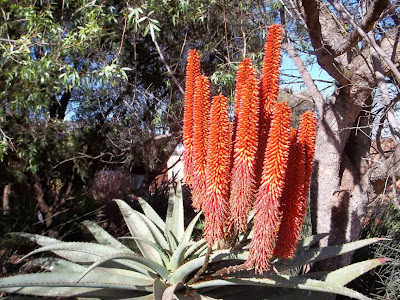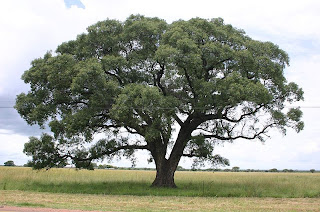This is an epiphyte or air plant. It is a plant that grows upon another plant (such as a tree) non-parasitically or sometimes upon some other object (such as a building or a telegraph wire), derives its moisture and nutrients from the air, rain, and sometimes from debris accumulating around it. Roots may develop primarily for attachment, and specialized structures (for example, cups and scales) may be used to collect or hold moisture.
When this was given to me by a friend, it was a mere three inches long and after about 3 years, is now a whopping twelve inches! But much to my own chagrin, it should have been much bigger by now had I not neglected it, also labouring under the misconception that it didn't need any extra water apart from rain.
This one hasn't developed any roots and is just wedged between a dead branch and the tree trunk. Epiphytic organisms usually derive only physical support and not nutrition from their host.
This one might well be Tillandsia albida, in the family Bromeliaceae (Bromiliad), but I'm not sure. There are over 550 species of Tillandsia (plus many hybrids), that grow in the Mexico, South and Central Americas.
Bromeliad Tillandsia have a life cycle of one plant growing to maturity and blooming. Before, during or after blooming (depending on the species) your plant will start producing young (PUPS), most plants will produce between 2 - 8 pups which in turn will mature, generally within a year and in turn bloom and produce pups.
General Info
- Tillandsias DO have to be watered, they live 'in' air, not 'on' air.
- Tillandsias are NOT toxic to animals, although this does not mean your pet won't eat them, but they will survive the experience, your plant might not.
- Tillandsias are NOT parasitic, they do not harm the host tree.
- Trim away brown, bent or damaged leaves, this will not hurt the plant.
Watering
Watering is one of the most important aspects of succeeding with Tillandsias, and one of the most misunderstood. Because their common name is Air Plants people tend to think of these plants as needing little or no water (as living on air). This is the biggest mistake you can make. Tillandsias NEED water, although they can survive for long periods of drought, they are NOT GROWING and certainly not thriving in these conditions, they are going dormant and just trying to survive, and will eventually die if water is scarce for too long, though its amazing how long they'll "hang in there" with very little water.
Thoroughly wet your Tillandsia 2-3 times per week; more often in a hot, dry environment; less often in a cool, humid one. They need to be watered (underneath as well as on top) to the point of runoff as though they've just gone through a rain storm, AT LEAST twice a week. The easiest way to achieve this is to actually immerse the whole plant in the sink or a bucket if possible, if not, use a hose or the kitchen faucet to totally wet your plant. Your plant will also appreciate a good soaking for several hours every one to two weeks.
FERTILIZING
They do not need much in the way of fertilizer - in fact it is better not to give them any fertilizer. Some growers like to give a little liquid fertilizer (diluted 25%) a couple of times a year to assist in flowering and to speed up the production of 'pups' - the baby plants. Do not over fertilize. Also, do not use distilled water when watering as this can cause the nutrients in the leaves to leach out of the plant.
NEVER 'plant' your Tillandsia. Putting a Tillandsia in soil is almost certain death to your plant. If you want it in a pot to look like a normal plant and you need to add some weight to stop it falling over, use gravel, pebbles or any other medium that drains rapidly. If your plant is placed in anything that holds water or moisture and doesn't dry out between waterings it will ROT!!! This is not a good thing!!!

Mounting your Tillandsia
Tillandsias can be grown basically anywhere, on rocks, in a seashell or on coral, in ceramic or pottery, attached to wood (not pressure treated wood this is impregnated with copper, and copper will kill your plant), in a fork of a tree. Pin them on your curtains, make a wreath, attach to velcro and stick them on your mirror, attach them to a piece of wood and hang the wood in your tree (that way you can bring your plant in when its going to freeze). Glue onto a pebble or decorative stone, attach to magnets, hang on your front door, attach them to a piece of lattice so they can be hung indoors or outdoors, put them in terrariums (great decorations for use with lizards, snakes etc.). About the only limit is your imagination (with a few exceptions).
Reasons Bromeliads Tillandsias Die
# They were not initially
cared for properly (their owner was told they need little or no
water).
# Thick- and thin-leaf varieties were combined in the same container (different
watering schedules).
# They did not get enough light (they were more than 10 feet from a bright window
or skylight).
# They were placed in DIRECT SUN. Garden windows are generally too warm unless they are shaded or facing south (in the Southern hemisphere).
DON'T :
# Don't
worry about roots. You can cut them off to make it easier to place them in
containers (they will grow back). This also makes it easier to water them.
# Don't leave water sitting in the crevices of big, fleshy Bromeliads - Tillandsias.
Shake them off!
# Don't put them in containers that hold moisture around the base (or, let them dry
well before returning them to their containers).
# Don't throw Bromeliad Tillandsias away if there is any green left to the plants.
Soak them for 24 hours.
# Don't soak the flower while in bloom (prolonged periods of soaking will rot them).
# Don't water plants in clumps as much, as clumped Bromeliad - Tillandsias hold
more moisture.
# Don't combine thick- and thin-leaf varieties in the same container, since their
watering schedules will be different.
# Don't let them freeze!
SUMMARY
- Constant air circulation -- as the name indicates -- is paramount to keeping your plant happy.
- Air plants need water; from late spring to mid-autumn, mist daily. In winter, mist only once or twice a week and once a month give them a good soaking.
- Fertilize monthly in spring and summer using a low-nitrogen liquid fertilizer mixed at only one-quarter strength. In general, fertilize weakly.
- Although they love warm weather, most air plants need protection from full sun. If it's a type that grows naturally wild on trees, keep it in moist, partial shade. If it is a ground type, such as T. cyanea or T. lindenii, grow it indoors in bright, filtered light and outdoors in partial or dappled shade.
- Don't let an air plant sit somewhere that's colder than 45 degrees; it will die at those temperatures. If you live in Zone 9 or warmer, you can grow an air plant outdoors all year if you keep it dry during the winter.
For more great info on care and on how to revive a neglected plant, read more
HERE
Read more on
grooming your Tillandsia
PIC credit

Airplant Tillandsia with 3 open flowers and daughter plant
::











































